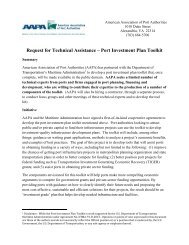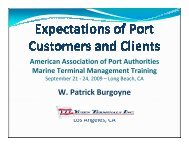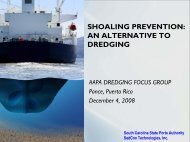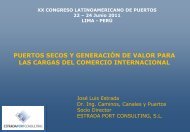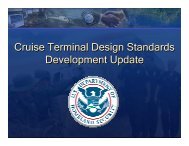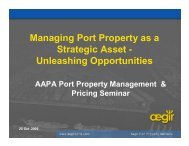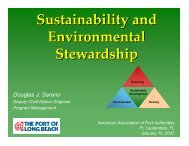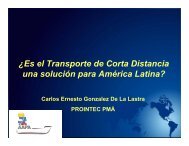Luciano Corbetta - staging.files.cms.plus.com
Luciano Corbetta - staging.files.cms.plus.com
Luciano Corbetta - staging.files.cms.plus.com
Create successful ePaper yourself
Turn your PDF publications into a flip-book with our unique Google optimized e-Paper software.
Case Studies on Sustainable Practices in Australasian,European & Middle Eastern PortsAAPA - Facilities Engineering Seminar<strong>Luciano</strong> <strong>Corbetta</strong>P&M Market Unit Manager, Cavotec SANovember 10 th 2011, New Orleans (LA)©2010 | Thursday, 17 November 2011 | Slide 1
OverviewIntroductionTechnologies• Electrification• Automation• Alternative fuelsWorldwide implementation• Europe• Asia• Australia• Middle East©2010 | Thursday, 17 November 2011 | Slide 2
IntroductionLearning from worldwide best practices to improve sustainability in the new portdevelopment: Australasia, Europe and Middle Easthas be<strong>com</strong>e the source of growing concern inthe public and private sectors in recent years,with the maritime and port industry beingforced to take steps to answer calls forimproved air quality in ports and surrounding<strong>com</strong>munities as a result.In the case of port equipment or ships duringthe port stay, reducing diesel engine emissionsis one of the keys to mitigating the hazardouseffects of nitrous oxide (NOx), carbon dioxide(CO2) and particulate matter (PM) in andaround terminals, as well as helping to meetnational greenhouse gas (GHG) reductiongoals as part of international climate changeefforts.©2010 | Thursday, 17 November 2011 | Slide 3
TechnologiesElectrificationIn ports part of the Cargo Handling Equipment, like the RTG cranes, and the ships,during the docking, are normally powered by Gen-Set / Auxiliary EnginesRTGsShipsPowered by a single Gen-SetPower rage between 350 kW and 500 kWOne or more Auxiliary Engines Power up to 10 MW for AE©2010 | Thursday, 17 November 2011 | Slide 4
TechnologiesElectrificationRTGs Electrification©2010 | Thursday, 17 November 2011 | Slide 5
TechnologiesElectrificationShore connection0,90,80,70,60,50,40,30,20,10PMAE engines using2.7 % sulphurcontent fuelAE engines using0,1 % sulphurcontent fuelEU25 electricityproduction©2010 | Thursday, 17 November 2011 | Slide 6
TechnologiesElectrificationCO2 emission reductionGenerally AEs emit 690-722 grams CO2 per kWh electricity (exact value depend fromtype of engine and type of fuel)Compare to the CO2 emission from electricity generation in different countries aroundthe worldSource:Resources, Conservation and Recycling54(2010) 462-467Assessment of CO2 and priority pollutantreduction by installation ofshoreside powerW.J. Hall©2010 | Thursday, 17 November 2011 | Slide 7
TechnologiesAutomationAutomation is the one of the most effective way to save energy. Simply using energy better isa cost-effective way of cutting Air emission.It is often the cheapest and quickest route to reduce the environmental impact of PortoperationAutomation can be applied to not only to the Cargo Handling Equipment but also to shipdocking operation©2010 | Thursday, 17 November 2011 | Slide 8
TechnologiesAutomationAutomatic stacking cranes (ASCs)Saving is in being able to operate several cranes simultaneously and in doing so, toeven out their energy consumption. In other words, when energy is generated at onelocation, it can be used by another crane in the same supply grid. Studies show thateven with just ten cranes operating at the same time, an optimum situation can beattained whereby energy is simultaneously generated and consumed, resulting insavings of about 30%.Source:ENERGY AND ENVIRONMENTAL EFFICIENCY IN PORTS & TERMINALSPEMA information paper©2010 | Thursday, 17 November 2011 | Slide 9
TechnologiesAutomationAutomatic Mooring SystemThe use of the Automatic mooring System permit energy saving thanks to:• Shortening waiting time• Shortening the time needed by the mooring• Shortening the time of the port stay• Shortening the use of the Tug• Improved efficiency of the cargo operation©2010 | Thursday, 17 November 2011 | Slide 10
TechnologiesAlternative FuelsNatural Gas• The use of the natural gas instead of other fossil fuel permit to reduce consistentlyair emission.• Natural gas does not contain sulfur or heavy metals. When burned, it also emitslower levels of CO 2 than naphtha, coal, oil or liquefied petroleum gas• Thanks to its high energy density Liquefied natural gas (LNG) is use in some port asfuel for the terminal tractor, but also on board of ships for the main propulsion andauxiliary electricity production.• Many study and pilot project are carried out for an extensive use of LNG in ports(CHE powering and energy production)©2010 | Thursday, 17 November 2011 | Slide 11
TechnologiesAlternative FuelsNatural Gas emission <strong>com</strong>parison©2010 | Thursday, 17 November 2011 | Slide 12
Worldwide implementationEuropeBaltic Sea PortsRo-Ro vessel TerminalsShore connectionFollowing ports in Baltic Sea have installed shore connection:• Gothenburg• Luebeck• Kemi• Oulu• Karlskrona• Trelleborg• Oslo• Totally 10 berth are equipped with the shore connection andother 4 are under construction• Power is supplied at 10 kV at 50Hz or 60 Hz (using a staticfrequency converter)• The EU decided recently that Sweden will be permitted tomake exceptions to the Energy Tax Directive. The SwedishGovernment was therefore able to cut the tax on power forvessels at the quayside by 98 per cent©2010 | Thursday, 17 November 2011 | Slide 13
Worldwide implementationEuropeBaltic Sea Ports - Ro-Ro vessel Terminals -Shore connectionCable Dispenser in rest positionCable Dispenser in operation©2010 | Thursday, 17 November 2011 | Slide 14
Worldwide implementationEuropePort of Hamburg (Germany) -Container Terminal Altenwerder (CTA)Automatic Stacking Cranes• 52 unit installed• In operation since 2002• One inner and one outer crane on each block©2010 | Thursday, 17 November 2011 | Slide 15
Worldwide implementationEuropeAutomatic Stacking Cranes• Over 260 ASCs installed in Europeinstalled• Other over 100 unit to be installed inthe next 3 yearsEuromax Terminal, Rotterdam58 ASCsECT, Rotterdam: 137 ASCs©2010 | Thursday, 17 November 2011 | Slide 16
Worldwide implementationEuropeClean North Sea ShippingAlternative Fuel: LNGA new project lead by Port Authorities together with other partners to develop storagefacilities in the Baltic/North Sea in order to be able to supply LNG to ship for mainpropulsion and auxiliary electricity production©2010 | Thursday, 17 November 2011 | Slide 17
Worldwide implementationAsiaShenzhen Port (China)Shekou Container TerminalShore connection• 2 berths of 9 nine electrified• Power supplied 6.600 V at 60/50 Hzor alternatively 440 V at 60/50 Hz• 5 MVA Static frequency converterinstalled (MV converter)• Containerized solution for FC• Flat rack equipped with• MV Switchboard• Step down transformer• Low Voltage cable reelsFrequency converter container©2010 | Thursday, 17 November 2011 | Slide 18
Worldwide implementationAsiaShenzhen Port (China)Shekou Container TerminalShore connectionShip equipped for shore powerFlat rack for LV power supplyLV cable connection©2010 | Thursday, 17 November 2011 | Slide 19
Worldwide implementationAsiaPercentage of vessels in servicewith AMP equipmentPercentage of post-panamax vessels withAMP order by scheduled delivery date2011 - 20157%28%93%Cavotec AMPAMP72%4,000 to 15,000 TEU containershipsupdated 1 Dec 2010New-builds update 01-Janauary-2011Source: Boxfile 1 Dec 2010, container vessel 4000-ULCS TEUSource: boxfile 1 Janauary 2011, container vessel 4000-ULCS TEU©2010 | Thursday, 17 November 2011 | Slide 20
Worldwide implementationAsiaHong Kong Port (HK) -Modern Terminals Ltd. - E-RTG• Retrofitting of 78 RTG cranes• Bus bar system• Power supply at 460 V at 50 Hz• Automatic connection and disconnection to busbar• RTG auto steering implemented©2010 | Thursday, 17 November 2011 | Slide 21
Worldwide implementationAsiaHong Kong Port (HK) -Modern Terminals Ltd. - E-RtgBus bar detailBus bar connection pointAutomatic arm©2010 | Thursday, 17 November 2011 | Slide 22
Worldwide implementationAustraliaPort Headland (Western Australia) - Utah Point Multi-User Bulk Export Facility -Automatic Mooring System• Moor Master type MM200B• 14 unit installed for a total holding capacity of 2,800 KN• Tide range 6,5 m.• Passing vessel during operation• Service 1 daily mooring of dry bulk carriers up to 135kdwt, 295m LOA©2010 | Thursday, 17 November 2011 | Slide 23
Worldwide implementationAustraliaPort Headland (Western Australia) - Utah Point Multi-User Bulk Export Facility -Automatic Mooring SystemVacuum pad installed on vertical railsVacuum pad detailHuang Shan Hai, 2nd ship moored at PHPA©2010 | Thursday, 17 November 2011 | Slide 24
Worldwide implementationAustraliaPort Headland (Western Australia) - Utah Point Multi-User Bulk Export Facility -Automatic Mooring System2011 WA Engineering Excellence Award©2010 | Thursday, 17 November 2011 | Slide 25
Worldwide implementationMiddle EastPort of Salalah (Oman)Berth 6 and 1Automatic Mooring System• Cavotec MoorMaster type MM200 & MM600• 4 unit installed on berth 6 for a total holding capacity of 2,400 kN• 12 unit installed on berth 1 for a total holding capacity of 2,400 kN• Long waves effecting port operation during Monsoon Season• Service 2 daily mooring of container ship up to 362m LOA©2010 | Thursday, 17 November 2011 | Slide 26
Worldwide implementationMiddle EastPort of Khalifa (UAE)ADPCAutomatic Stacking Cranes• In operation from mid 2012• 6 unit already fully erected on site• Totally 24 ASCs©2010 | Thursday, 17 November 2011 | Slide 27
©2010 | Thursday, 17 November 2011 | Slide 28Thank you for your attention



